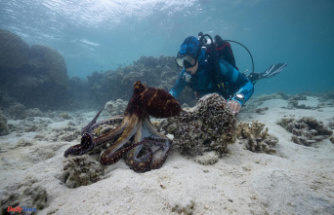"I beg your majesty to permit me to confess to her the desire I feel to signalize my zeal, and the honor she would do me to serve in her troops by offering her the proof of complete devotion. This is the convoluted formula learned by heart by Prince Aniaba of Assinie in view of his audience, in 1691, by the King of France.
The scene takes place at the Palace of Versailles and the young African who speaks is only 19 years old. An aristocrat, originally from the Ehotilé islands bringing together several peoples of the future Côte d'Ivoire, he was sent to France by his adoptive father, King Niamkey of Essouma in order to "greet the king and admire the magnificence of his kingdom".
Indeed, at first wary of Europeans trading with Africa - for "isn't it said that they devour their fellows, which is why they procure slaves and take them to their country, d 'where these poor young people never return' - King Niamkey was convinced of the good faith of the French when Louis XIV made him return compatriots who had been captured by a pirate.
"This kindness of our great monarch has produced such good effects on the mind of the King of Assinie and all his people that he now looks to the French as the protectors of his kingdom", reports on this subject the missionary Brother Gonsalvez.
A whole different world
This is how Prince Aniaba was sent to France to discover the country, study its language, its religion and meet its monarch. Born in 1672, Aniaba learned swordsmanship, fishing, musical traditions, history, the significance of his people's festivals and customs - including "the generation festival", the ceremony that makes a child a adult, which lasts several months and "renews the pact with the ancestors. He also has knowledge of botany and science, he understands the myths and spirituality of his people.
In France, he will have to adapt to a completely different world and also convert to Catholicism. But he let himself be convinced that like the “boss” of his religion, “Jesus serves as an intermediary between God and men. Like the bosson, it calls to distinguish between good and evil. Like the bosson, he delegates his presence to the Komians (priests or nuns) to act in his name.
His French adventure will be both trying and happy. Once blessed by his family and accompanied by Anouman, his childhood friend, Aniaba embarked in 1687 on the Saint-Louis, an impressive three-deck ship, but whose full holds let out a terrible human stench...
How does the young prince manage to meet the King of France four years later? Why does he wish to serve him by entering the elite military corps of Musketeers if possible? And how can his personal itinerary take place at a time when France and Europe practice the human trafficking of the slave trade?
A story rich in images
It is this breathtaking journey that Serge Bilé's new book, Aniaba, the musketeer of Notre-Dame de Paris, tells. Since his first works, in the mid-2000s, the Ivorian journalist has endeavored to document the history of relations between Africa and the rest of the world by highlighting, depending on the subject, unusual life trajectories or unexpected situations. The essayist was thus able to evoke the black presence in the Nazi camps, the fate of the only black passenger of the Titanic, that in Japan of the samurai of African origin Yasuké or even the triumphal tours on the continent of the French stars "yé-yé" of the 1960s.
Just as original as his previous works, Aniaba, the musketeer of Notre-Dame de Paris takes us back in time to the 17th century through a story rich in images, narrated like a film where the characters are staged with great detail. and tasty anecdotes. However, the author's idea is not to completely "fictionalize" this era, but on the contrary to build a text from real information. The journalist does indeed rely on the work of historians, anthropologists, archaeologists, ethnobotanists, as well as on what religious people and travelers of the time reported.
It is from these bibliographical references, the list of which is gathered at the end of the book, that he weaves his reconstruction, inviting readers – young audiences as well as adults – to follow him in a story cut up into short chapters that escape the usual classifications. Besides re-dimensioning in their own way the common idea of a history of Africa limited to the ante and postcolonial dichotomy, the adventures of Aniaba are significant of a relationship established in the 17th century by the (future) Ivorians with France.
Relationships which, thanks to the musketeer Louis-Jean Aniaba d'Assinie, have endured beyond time. Two months after the fire of Notre-Dame, in 2019, did not the monarch Amon N'Douffou V make a donation for the reconstruction of the cathedral, explaining his gesture by the "strong link" which unite his kingdom with Paris?












